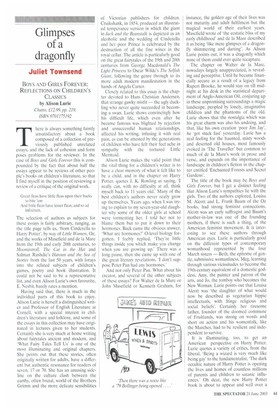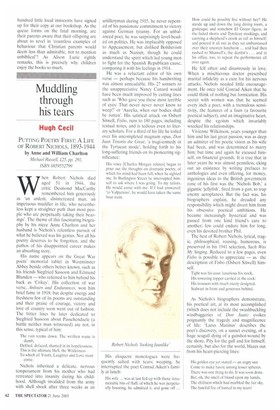Glimpses of a dragonfly
Juliet Townsend
BOYS AND GIRLS FOREVER: REFLECTIONS ON CHILDREN'S CLASSICS by Alison Lurie Chatto. £12.99, pp. 219, ISBN 0701175192 There is always something faintly unsatisfactory about a book composed of a collection of previously published unrelated essays, and the lack of cohesion and form poses problems for the reviewer. In the case of Boys and Girls Forever this is compounded by the fact that about half the essays appear to be reviews of other people's books on children's literature, so that I find myself in the position of reviewing a review of a critique of the original work.
Great fleas have little fleas upon their backs to bite 'em And little fleas have lesser fleas, and so ad infinitum.
The selection of authors as subjects for these essays is fairly arbitrary, ranging, as the title page tells us, from Cinderella to Harry Potter', by way of Little Women, Oz, and the works of Masefield and de la Mare from the 19th and early 20th centuries, to Moornintroll, The Cat in the Hat and Salman Rushdie's Haroun and the Sea of Stories from the last 50 years, with forays into the related subjects of children's games, poetry and book illustration. It could not be said to be a representative list, and even Alison Lurie's own favourite, E. Nesbit, barely rates a mention.
Having said that, there is much in the individual parts of this book to enjoy. Alison Lurie is herself a distinguished writer and Professor of English Literature at Cornell, with a special interest in children's literature and folklore, and some of the essays in this collection may have originated in lectures given to her students. Certainly she is very much at home writing about fairytales ancient and modern, and 'What Fairy Tales Tell Us' is one of the most illuminating and original chapters. She points out that these stories, often originally written for adults, have a different but authentic resonance for readers of seven, 17 or 70. She has an amusing sideline on the culture clash between the earthy, often brutal, world of the Brothers Grimm and the more delicate sensibilities of Victorian publishers for children. Cruikshank, in 1854, produced an illustrated temperance version in which the giant in Jack and the Beanstalk is depicted as an alcoholic and the wedding of Cinderella and her poor Prince is celebrated by the destruction of all the fine wines in the royal cellar. The article is particularly good on the great fairytales of the 19th and 20th centuries from George Macdonald's The Light Princess to Oscar Wilde's The Selfish Giant, following the genre through to its more adult modern manifestation in the hands of Angela Carter.
Closely related to this essay is the chapter devoted to Hans Christian Andersen,
that strange gawky misfit the ugly duckling who never quite succeeded in becoming a swan. Lurie shows convincingly how his difficult life, which even after he became famous was blighted by rejection and unsuccessful human relationships, affected his writing, infusing it with real pain, as can be attested by the generations of children who have felt their feet ache in sympathy with the tortured Little Mermaid.
Alison Lurie makes the valid point that the vital thing for a children's writer is to have a clear memory of what it felt like to be a child, and in the chapter on Harry Potter, quotes J. K. Rowling as saying, 'I really can, with no difficulty at all, think myself back to 11 years old.' Many of the best children's authors never really grow up themselves. Years ago, when I was trying to explain to my seven-year-old daughter why some of the older girls at school were tormenting her, I told her not to blame them but to put it down to their hormones. Back came the obvious answer, 'What are hormones?' 0-level biology forgotten, I feebly replied, 'They're little things inside you which make you change when you are growing up.' There was a long pause, then she came up with one of the great literary revelations, 'I don't suppose Peter Pan had any hormones.'
And not only Peter Pan. What about his creator, and several of the other subjects of these essays? For Walter de la Mare or John Masefield or Kenneth Graham, for instance, the golden age of their lives was not maturity and adult fulfilment but the magical world of their earliest years. Masefield wrote of the ecstatic bliss of my early childhood' and de la Mare described it as being 'like mere glimpses of a dragonfly shimmering and darting'. As Alison Lurie points out, it was a dragonfly which none of them could ever quite recapture.
The chapter on Walter de la Mare, nowadays largely unappreciated, is revealing and perceptive. Until he became finan cially secure as a result of a legacy from Rupert Brooke, he would stay on till midnight at his desk in the statistical depart ment of Anglo-American Oil, conjuring up in these unpromising surroundings a magic landscape, peopled by lonely, imaginative
children and the phantoms of the old.
Lurie shows that the nostalgia which was his great charm was also his undoing, and
that, like his own creation 'poor Jim Jay'.
he 'got stuck fast' yesterday. Lurie has a real feeling for the haunted, misty woods and deserted old houses, most famously
evoked in -The Traveller' but common to much of de la Mare's work in prose and verse, and expands on the importance of landscape in children's fiction in the chapter entitled 'Enchanted Forests and Secret Gardens'.
The title of the book may be Boys and Girls Forever, but I get a distinct feeling
that Alison Lurie's sympathies lie with the
girls. Two of the authors explored, Louisa M. Alcott and L. Frank Baum of the Oz
books, had strong feminist connections.
Alcott was an early suffragist and Baum's mother-in-law was one of the founding
mothers, if there is such a thing, of the American feminist movement. It is interesting to see these authors through American eyes. Lurie is particularly good on the different types of contemporary womanhood represented by the four March sisters — Beth, the epitome of gen tle, submissive womanliness, Meg, learning through various vicissitudes to become the 19th-century equivalent of a domestic god dess, Amy, the painter and patron of the arts, and Jo, the tomboy who becomes the New Woman. Lurie points out that Louisa Alcott was 'the daughter of what would now be described as vegetarian hippie intellectuals, with fringe religious and social beliefs'. Certainly her tiresome father, founder of the doomed commune
of Fruitlands, was strong on words and short on action and his womenfolk, like the Marches, had to be resilient and independent to survive.
It is illuminating, too, to get an American perspective on Harry Potter.
Lurie quotes a variety of critics, from the liberal, 'Being a wizard is very much like being gay' to the fundamentalist, 'The dark
occultic nature of Harry Potter is opening the lives and homes of countless millions of parents and children to satanic influences.' Oh dear, the new Harry Potter book is about to appear and well over a hundred little local innocents have signed up for their copy at our bookshop. As the queue forms on the fatal morning, are their parents aware that their offspring are about to revel in 'countless examples of behaviour that Christian parents would deem less than admirable, not to mention unbiblical'? As Alison Lurie rightly remarks, this is precisely why children enjoy the books so much.



































































































 Previous page
Previous page